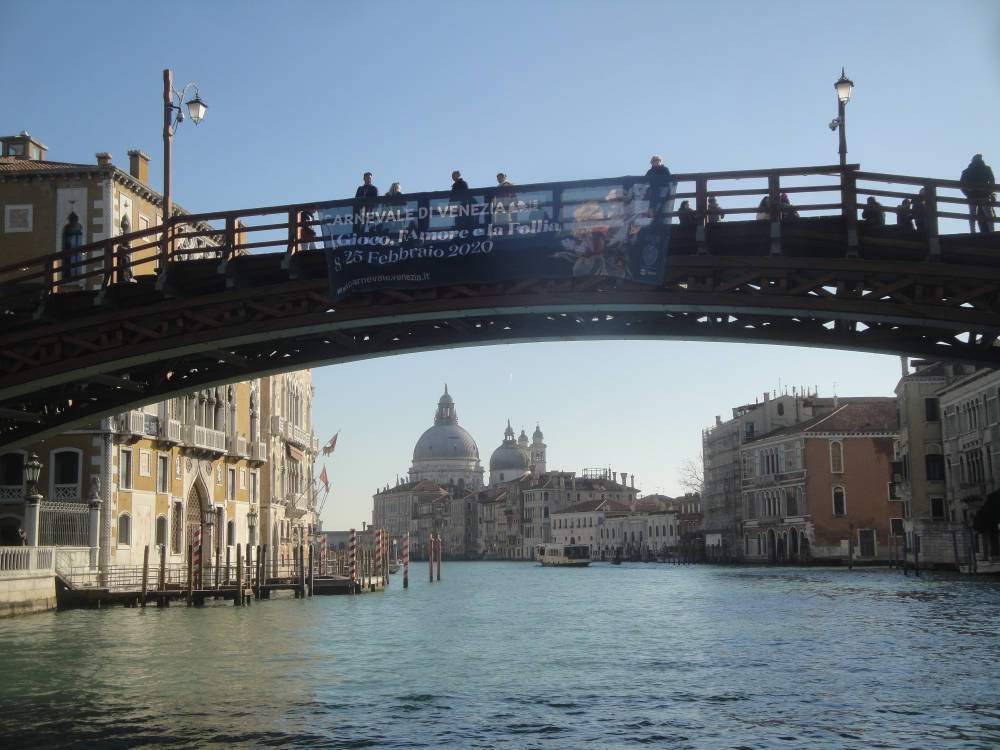
La Basilica di Santa Maria della Salute, Venice Architect: Baldesare Longhena [1598-1682]. 1631-87. Completed by Antonio Gaspari after Longhena's death. The 125 statues that adorn the exterior of Salute form a sharp contrast to the austere interior. Click on images to enlarge them.
In The Stones of Venice John Ruskin points out that Santa Maria della Salute is “one of the earliest buildings of the Grotesque Renaissance, rendered impressive by its position, size, and general proportions. These latter are exceedingly good; the grace of the whole building being chiefly dependent on the inequality of size in its cupolas, and pretty grouping of the two campaniles behind them. . . . The Church of the Salute is farther assisted by the beautiful flight of steps in front of it down to the canal; and its facade is rich and beautiful of its kind, and was chosen by Turner for the principal object in his well-known view of the Grand Canal” (11.428). Still, says Ruskin, the building is not perfect: “The principal faults of the building are the meagre windows in the sides of the cupola, and the ridiculous disguise of the buttresses under the form of colossal scrolls; the buttresses themselves being originally a hypocrisy, for the cupola is stated by Lazari to be of timber, and therefore needs none.”


Left: View approaching the side with the church entrance (i.e, from the opposite angle of the picture above). Right: On this photograph taken from a boat that has passed the front of the church we see the church’s two towers.
Ruskin also explains that “‘Santa Maria Della Salute,’ Our Lady of Health, or of Safety, would be a more literal translation, yet not perhaps fully expressing the force of the Italian word in this case. The church was built between 1630 and 1680, in acknowledgment of the cessation of the plague;—of course to the Virgin, to whom the modern Italian has recourse in all his principal distresses, and who receives his gratitude for all principal deliverances” (10.443). He next directs the reader’s attention to another, smaller church “on the opposite side of the broad canal of the Giudecca . . . celebrated among Renaissance architects as of Palladian design, but which would hardly attract the notice of the general observer” — the Redentore or Redeemer. He asks the reader “carefully to compare these two buildings with each other, the one built ‘to the Virgin,’ the other ‘to the Redeemer’ (also a votive offering after the cessation of the plague of 1576): the one, the most conspicuous church in Venice, its dome, the principal one by which she is first discerned, rising out of the distant sea; the other, small and contemptible, on a suburban island, and only becoming an object of interest because it contains three small pictures! For in the relative magnitude and conspicuousness of these two buildings, we have an accurate index of the relative importance of the ideas of the Madonna and of Christ, in the modern Italian mind.”



Sculpture on the church exterior: the main door, columns, and statues and a detail of the wall to the immediate right.

Santa Maria della Salute seen in the distance from beneath the Academia Bridge.
Henry James on Santa Maria della Salute
We have been treated to it again and again, of course, even if we have never stirred from home; but that is only a reason the more for catching at any freshness that may be left in the world of photography. It is in Venice above all that we hear the small buzz of this vulgarising voice of the familiar; yet perhaps it is in Venice too that the picturesque fact has best mastered the pious secret of how to wait for us. Even the classic Salute waits like some great lady on the threshold of her saloon. She is more ample and serene, more seated at her door, than all the copyists have told us, with her domes and scrolls, her scolloped buttresses and statues forming a pompous crown, and her wide steps disposed on the ground like the train of a robe. This fine air of the woman of the world is carried out by the well-bred assurance with which she looks in the direction of her old- fashioned Byzantine neighbour; and the juxtaposition of two churches so distinguished and so different, each splendid in its sort, is a sufficient mark of the scale and range of Venice. — Henry James, Italian Hours
Related material
- Joseph Mallord William Turner’s Venice - Maria della Salute
- Joseph Mallord William Turner’s Venice with the Salute
- Sir Frank Brangwyn’s Santa Maria [della Salute] through the Rigging
- Sir Frank Brangwyn’s Santa Maria della Salute
Photographs George P. Landow October 2000 and Robert Freidus 2020. [You may use these images without prior permission for any scholarly or educational purpose as long as you (1) credit the photographer and (2) link your document to this URL.]
Bibliography
The beautiful Everyman Guide to Venice (1993), which is based on an earlier Gallimard publication (Paris, 1992), has a magnificent cutaway illustration of Salute and some beautiful details (318-19).
James, Henry. Italian Hours. Etext prepared by Richard Farris (rf7211@hotmail.com) and proofread by the online team at Distributed Proofreaders. Web. 12 April 2012.
�
Last modified 24 March 2020